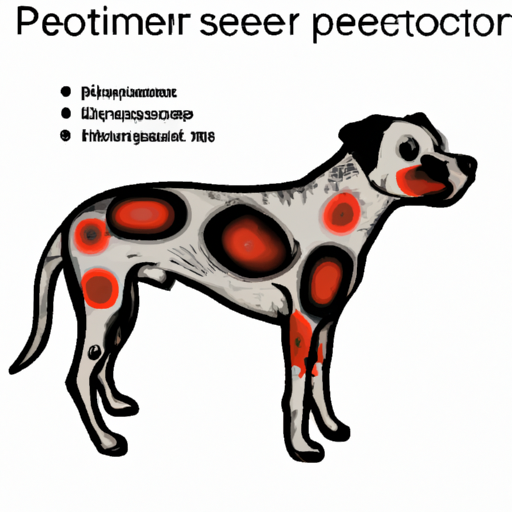As a dedicated caregiver to your furry friend, it’s essential to be aware of health issues that can affect your dog. One such condition is hot spots, also known as acute moist dermatitis. These are painful, swollen, and warm patches on your dog’s skin that can cause your pet great discomfort. In this article, we delve into what hot spots on dogs look like, what causes them, how they’re treated, and ways to prevent them.
- Table of Contents
- Understanding Hot Spots
- What Do Hot Spots Look Like?
- Causes of Hot Spots
- Treatment and Prevention
-
Frequently Asked Questions
-
Key Takeaways
- Hot spots are uncomfortable skin conditions that can affect any breed of dog.
- They appear as inflamed, moist, and reddish areas on your dog’s skin.
- Bacterial infections, allergies, and excessive licking or scratching can cause hot spots.
- Treatment involves cleaning the area, using prescribed medications, and preventing further irritation.
- Regular grooming, healthy diet, and flea prevention can help avoid hot spots.
Understanding Hot Spots
Hot spots are a common skin condition in dogs, characterized by inflamed, infected, and itchy patches on the skin. They can appear suddenly and spread rapidly, causing your dog significant discomfort. This article from Cornell University provides in-depth information on hot spots and other skin conditions in pets.
According to OneTopDog, hot spots can affect any breed of dog, but they’re more common in breeds with thick coats, such as Golden Retrievers and German Shepherds.
What Do Hot Spots Look Like?
Hot spots are typically red, swollen, and moist. They can vary in size, but they tend to grow rapidly. The affected area may be hairless, and you might notice your dog excessively licking, scratching, or biting at it. The skin may also ooze pus or a foul-smelling discharge.
Here are some key characteristics to look for:
- Reddened, inflamed skin
- Loss of hair in the affected area
- Swelling or warmth
- Oozing pus or discharge
- Unpleasant odor
For a visual guide on what hot spots look like, check out this page on OneTopDog.
Causes of Hot Spots
Hot spots are often the result of a bacterial infection. The bacteria can enter your dog’s skin through a small cut or scrape, or they can thrive in warm, moist conditions, such as beneath a dog’s thick fur. Allergies, fleas, mites, poor grooming, and even stress can also trigger hot spots.
Here are some common causes:
- Allergies (food, environmental)
- Flea or mite infestations
- Poor grooming
- Moisture trapped in the fur
- Cuts or abrasions
- Stress or boredom leading to excessive licking or chewing
Treatment and Prevention
Effective treatment of hot spots involves cleaning the area, administering prescribed medications, and preventing your dog from further irritating the area. You should consult your vet for a proper diagnosis and treatment plan.
Here’s a general process of treating hot spots:
- Shave or trim the hair around the affected area to allow it to dry out and heal.
- Clean the area with a mild antiseptic.
- Apply a topical treatment or antibiotic as prescribed by your vet.
- Use an Elizabethan collar (E-collar or “cone”) to prevent your dog from licking or scratching the area.
- Monitor the area closely and follow up with your vet if the condition doesn’t improve.
Preventing hot spots involves regular grooming, a healthy diet, flea prevention, and alleviating stress or boredom. Here is a comprehensive grooming guide from OneTopDog that can help you keep your dog’s skin healthy.
Frequently Asked Questions
1. Are hot spots contagious to other dogs or humans?
No, hot spots are not contagious. They’re the result of an overgrowth of bacteria that are normally present on your dog’s skin.
2. Can I use human medication on my dog’s hot spots?
You should never use human medication on your dog without consulting your vet. Some human medications can be toxic to dogs.
3. How long does it take for a hot spot to heal?
With appropriate treatment, most hot spots will start to heal within a few days and should completely heal within two weeks. However, it’s crucial to continue the treatment as prescribed by your vet, even if the hot spot appears to be healing.
By understanding what hot spots look like and knowing how to respond, you can ensure your pet gets the necessary care and treatment. Remember, when in doubt, always consult with a professional. Your dog’s health and comfort are worth it!



